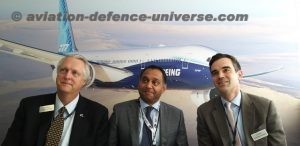Paris. 20 June 2019. “Answering tomorrow‘s challenges“: Never before has MTU Aero Engines had such good answers ready as today to tackle the challenges the aviation industry will be facing down the road. “We’re conscious of our responsibility for sustainable, emissions-free flying. That’s why we’re already investing today in pioneering technologies for the aviation of tomorrow,” explains MTU’s COO Lars Wagner. At this year’s Paris Air Show the company will present truly pioneering ideas and concepts: innovative evolutionary technologies for the next engine generation and also revolutionary technologies for the year 2050 and after.
“In the commercial segment, we’re researching several evolutionary approaches that are already possible today thanks to sustainable e-fuels. At the same time, we’re looking into alternative engine concepts ranging from hybrid-electric flight to fuel cells,” Wagner continues. With MTU’s contributions to the Geared Turbofan™ (GTF) engine, the company is impressively shaping developments in the industry of the present while preparing to shape the future like never before in the company’s history: the second GTF generation still offers considerable potential. Once it has been further optimized, it will dramatically reduce emissions and is due to be airborne by the mid-2030s.
Profile of commercial aviation in 2050
However, MTU’s experts are not satisfied to leave it at that; they are casting their gazes further into the future. Part of a small band of visionaries worldwide, they are already working with partners from industry and research on ideas for the commercial engines that could fly from 2050 onwards. Dr. Jörg Henne, Senior Vice President Engineering and Technology, explains: “MTU is working out revolutionary engine concepts to achieve the ambitious goals of Flightpath 2050. These new engine solutions have to go beyond today’s technology, with emissions-free flight the greater goal.”
Resourceful MTU developers have come up with two approaches and are combining the tried-and-tested gas turbine engine with brand new technologies: in the composite cycle approach, the conventional high-pressure compressor system is to be complemented by a piston compressor and engine. “This will allow us to significantly increase thermal efficiency,” says Dr. Stefan Weber, Senior Vice President Technology & Engineering Advanced Programs. The STIG cycle engine, meanwhile, integrates a steam power process into the gas turbine processes. This involves using a gas turbine with steam injection to feed the heat of the exhaust stream back into the process inside the engine. The wet combustion would substantially reduce both CO 2 and NOx pollutant emissions. “We’ll have to see which approach ultimately offers greater potential and is economically feasible,” Weber says. If this turns out to be the STIG cycle engine, it will not work in the current aircraft architecture, thus calling for a new configuration.
























































































































